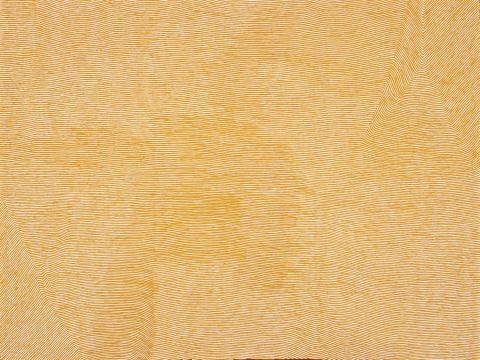CLAYPAN SITE OF MAMULTJULKULNGA, 2005
GEORGE TJUNGURRAYI
synthetic polymer paint on linen
182.0 x 243.0 cm
bears inscription verso: artist’s name, size and Papunya Tula Artists cat. GT0509213
Painted at Alice Springs in 2005
Papunya Tula Artists, Alice Springs
Hamiltons Gallery, London
The Luczo Family Collection, USA
Pintupi: 20 Contemporary Paintings from the Pintupi Homelands, Hamiltons Gallery, London, 28 June – 11 August 2006, cat. 3 (illus. in exhibition catalogue)
This painting is accompanied by a certificate of authenticity from Papunya Tula Artists that states: ‘The lines in this painting depicts the sandhills surrounding the claypan site known as Mamultjulkulnga, on the west side of Lake Mackay. The artist’s father passed away at this site. After rain the claypan becomes a freshwater lake. In mythological times, two Tingari Men of the Tjangala and Tjapaltjarri kinship subsections camped at this site. They gathered the seeds known as mungilypa or samphire from the small fleshy sub-shrub Tecticornia verrucosa. These seeds are ground into a paste which is cooked in the coals to form a type of unleavened bread.’
George Tjungurrayi is counted among the most senior of Pintupi artists, an exemplar of the finely honed canvases that distinguish the Papunya Tula Artists.
Tjungurrayi commenced his apprenticeship in the late in 1970s when assisting the founders of the movement on the mural-scaled canvases created at Papunya and its outstations. Older artists, such as Shorty LungkataTjungurrayi and Charlie Tarawa Tjungurrayi, drafted the intersecting paths of travelling ancestral heroes and established the palette and style of a particular work. Having cast the ‘image’, younger men, such as Tjungurrayi were called upon to assist painting the numerous bands of dotted infill that gave these great works such mesmerising vitality.1
Tjungurrayi is a highly skilled and meticulous man who, during the 1980s, proved eminently capable of producing his own paintings of the travelling Tingari ancestors. His national breakthrough came in the late 1990s as Pintupi artists distilled more minimal means of describing ancient stories. The quality of Tjungurrayi’s vision was recognised with solo shows at Utopia Art Sydney, 1997 and Gallery Gabrielle Pizzi, Melbourne, 1998 – landmark exhibitions comprised of serial works in which parallel bands of closely toned hues produced a dazzling effect. Tjungurrayi’s closely striped canvases thus transported the numinous realm of Pintupi metaphysics into the cool, neutral realm of the ‘white cube’.2
Vivien Johnson has compared Tjungurrayi’s approach to the Op Art masterpieces of Bridget Riley. In contrast to the British artist, who produced her effects with the parsimonious application of self-leveling paint, Tjungurrayi’s canvases were painstakingly constructed, each line formed with two layers of closely applied ‘dots’ that merge to become a palpable rib. When touched, Tjungurrayi’s paintings reveal a micro-topography that rhymes with the vast dune fields of the Gibson Desert.3
Physically, Tjungurrayi’s paintings echo the technique whereby Western Desert men would gouge the surface of hardwood weapons with finely wrought parallel grooves. The dynamism of Tjungurrayi’s designs evoke the Wunda shields in which sets of parallel, fluted grooves articulate on an imagined line then change direction before continuing at another angle. The resemblance is particularly compelling as the parallel bands of the Wunda are heightened with alternating bands of red-ochre and white pipe-clay.
Luke Scholes has written that Tjungurrayi had a direct influence on the work of his classificatory son and close countryman, Warlimpirrnga Tjapaltjarri, and indeed, both artists paint the site featured in the current work, Mamultjulkulnga. The fine bands of both artists are believed to have their origins in natural phenomena, such as the bands of differing coloured earths that are created on the receding edges of claypans as they dry.4
The power of Tjungurrayi’s enigmatic canvases emanates from the distillation of subtle details from a vast cryptic landscape. Through repetition, minimal signs come to represent a shimmering cosmological realm.
JOHN KEAN
1. Kean, J., 'A Big Canvas: Mobilising Pintupi Painting', in Colliding Worlds: First Contact in the Western Desert 1932-1984, Museum Victoria Publishing, Melbourne, 2006, pp. 47–52
2. Johnson, V., Lives of the Papunya Tula Artists, IAD Press, Alice Springs, 2008, p. 142
3. Ibid, p. 140
4. Myers, F. R. and Scholes, L., 'Warlimpirrnga Tjapaltjarri: Powerful Presence in Person and in Paint', in No Boundaries: Aboriginal Australian Contemporary Abstract Painting from the Debra and Dennis Scholl Collection, DelMonico Books, Prestel, Munich, 2014, pp. 136
